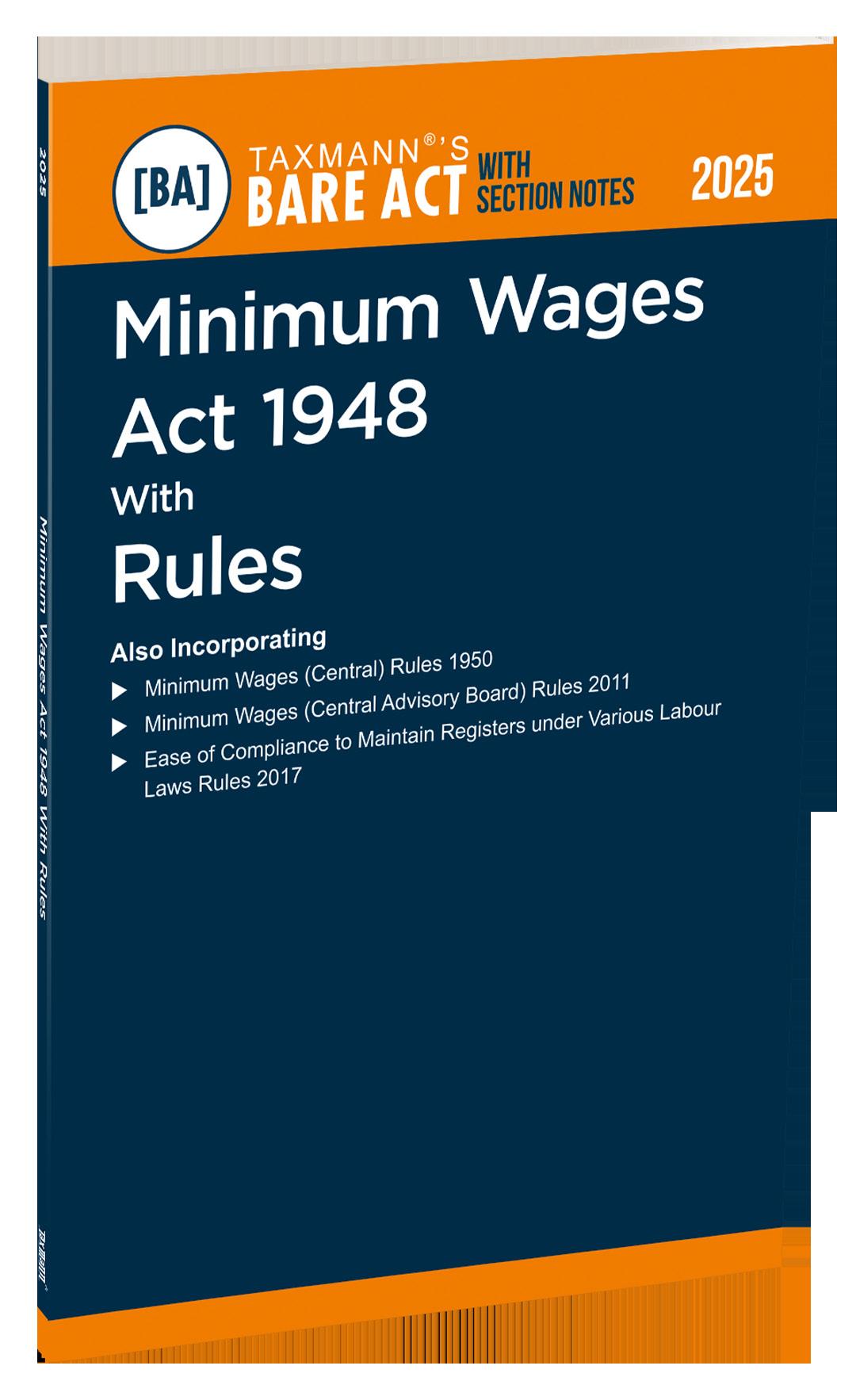

















[shall be repealed by Code on Wages, 2019,
[11 OF 1948]*
An Act to provide for fixing minimum rates of wages in certain employments.
WHEREAS it is expedient to provide for fixing minimum rates of wages in certain employments;
It is hereby enacted as follows:—
Short title and extent.
1. (1) This Act may be called the Minimum Wages Act, 1948. (2)It extends to the whole of India 1[***].
1.1 Short Title [Section 1(1)]
Sub-section 1 of section 1 of the Act declares the name of the legislation as the “Minimum Wages Act, 1948.”
1.2 Territorial Extent [Section 1(2)]
The Act applies to the entire geographical territory of India.
Interpretation.
2. In this Act, unless there is anything repugnant in the subject or context,—
2[(a) “adolescent” means a person who has completed his fourteenth year of age but has not completed his eighteenth year;
*Dated 15-3-1948.
1. Words “except the State of Jammu and Kashmir” omitted by the Central Labour Laws (Extension to Jammu and Kashmir) Act, 1970, w.e.f. 1-9-1971. Earlier, the quoted words were substituted for “except Part B States” by the Part B States (Laws) Act, 1951.
2. Substituted for clause (a) by the Child Labour (Prohibition and Regulation) Act, 1986, w.e.f. 23-12-1986. Earlier, clause (a) was amended by the Minimum Wages (Amendment) Act, 1954, w.e.f. 20-5-1954.
(
aa) “adult” means a person who has completed his eighteenth year of age;]
(b) “appropriate Government” means,—
(i) in relation to any scheduled employment carried on by or under the authority of the 3[Central Government or a railway administration], or in relation to a mine, oilfield or major port, or any corporation established by 4[a Central Act], the Central Government, and
(ii) in relation to any other scheduled employment, the State Government;
5[(bb) “child” means a person who has not completed his fourteenth year of age;]
(
c) “competent authority” means the authority appointed by the appropriate Government by notification in its Official Gazette to ascertain from time to time the cost of living index number applicable to the employees employed in the scheduled employments specified in such notification;
(
d) “cost of living index number”, in relation to employees in any scheduled employment in respect of which minimum rates of wages have been fixed, means the index number ascertained and declared by the competent authority by notification in the Official Gazette to be the cost of living index number applicable to employees in such employment;
(e) “employer” means any person who employs, whether directly or through another person, or whether on behalf of himself or any other person, one or more employees in any scheduled employment in respect of which minimum rates of wages have been fixed under this Act, and includes, except in sub-section (3) of section 26,—
(
i) in a factory where there is carried on any scheduled employment in respect of which minimum rates of wages have been fixed under this Act, any person named under 6[clause (f) of sub-section (1) of section 7 of the Factories Act, 1948 (63 of 1948)], as manager of the factory;
(ii) in any scheduled employment under the control of any Government in India in respect of which minimum rates of wages have been fixed under this Act, the person or authority appointed by such Government for the supervision and control of employees or where no person or authority is so appointed, the head of the department;
(iii) in any scheduled employment under any local authority in respect of which minimum rates of wages have been fixed under this Act, the person appointed by such authority for the supervision and
3. Substituted for “Central Government, by a railway administration” by the Minimum Wages (Amendment) Act, 1957, w.e.f. 17-9-1957.
4. Substituted for “an Act of the Central Legislature” by the Adaptation of Laws Order, 1950.
5. Inserted by the Child Labour (Prohibition and Regulation) Act, 1986, w.e.f. 23-12-1986.
6. Substituted for “clause (e) of sub-section (1) of section 9 of the Factories Act, 1934 (25 of 1934)” by the Minimum Wages (Amendment) Act, 1954, w.e.f. 20-5-1954.
control of employees or where no person is so appointed, the chief executive officer of the local authority; (iv) in any other case where there is carried on any scheduled employment in respect of which minimum rates of wages have been fixed under this Act, any person responsible to the owner for the supervision and control of the employees or for the payment of wages;
2.1 Adolescent [Section 2(a)]
Adolescent refers to a person aged between 14 and 18 years.
2.2 Adult [Section 2(aa)]
Adult refers to a person who has attained the age of 18 years.
2.3 Child [Section 2(bb)]
Refers to a person under 14 years of age.
2.4 Cost of Living Index Number [Section 2(d)]
Refers to an officially declared number reflecting changes in the cost of living. It is used as a benchmark to adjust minimum wages periodically.
2.5 Wages [Section 2(h)]
Encompasses monetary remuneration for work but excludes:
Value of amenities like accommodation, light, water, or medical attendance.
Employer contributions to Provident Fund or Pension Fund.
Allowances for travel or expenses incurred due to job nature.
Gratuity payable at discharge.
2.6 Employee [Section 2(i)]
Includes all persons hired for manual, skilled, unskilled, or clerical work in scheduled employment, whether in-house or as out-workers.
Excludes members of the Armed Forces of the Union.
Scheduled Employment – Applicability to Quarrying Operations - The Supreme Court ruled that the employment of workers in the quarrying of Shahabad stone does not fall under “stone breaking or stone crushing” as defined in Item 8, Part I of the Schedule to the Minimum Wages Act. It distinguished quarrying of stratified limestone, used for flooring and roofing, from the commercial activities of breaking and crushing non-stratified rock for fragments. The judgment clarified that minimum wages fixed for stone breaking or crushing cannot extend to operations involving the quarrying of Shahabad stone. – Labour Inspector (Central) Hyderabad v. Chittapur Stone Quarrying Co. Pvt. Ltd. AIR 1972 SC 1177.
Definition of Employee – Exclusion of Teachers - The Supreme Court held that teachers of educational institutions cannot be classified as “employees” under section 2( i) of the Minimum Wages Act. It ruled that teaching is neither manual nor clerical work, whether skilled or unskilled, and thus falls outside the scope of the Act. Consequently,
the Court quashed a Haryana Government notification that sought to include teachers in the Act’s schedule for fixing minimum wages, emphasizing that such inclusion exceeds the State’s competence under section 27. – Haryana Unrecognised Schools Association v. State of Haryana AIR 1996 SC 2108.
Definition of Wages – Prohibition of Segregation - The Supreme Court ruled that the definition of “wages” under section 2(h) encompasses all remuneration payable for employment, including house rent allowance, but excludes benefits such as traveling allowances, medical attendance, and value of housing. It held that a prohibition on splitting wages into components, as specified in a government notification, is impermissible. Employers cannot be compelled to provide additional payments for allowances already covered within the defined wage package. This decision reaffirmed the limits of governmental authority under the Act. – Hindustan Sanitaryware and Industries Ltd. v. State of Haryana 2019 LAB. I. C. 2479.
Section 2
In section 2,—
After clause (g), the following clause shall be inserted :—
“(ga) State Government means the Lieutenant Governor of National Capital Territory of Delhi, appointed by the President under Article 239 and designated as such under Article 239AA of the Constitution.”— [Vide the Minimum Wages (Delhi) Amendment Act, 2017, w.e.f. 5-5-2018]
Section 2
In clause (e) of section 2, for the words, brackets and figures “and includes, except in sub-section (3) of section 26”, the words, brackets and figures “and includes a Person deemed to be an employer under section 18A and further includes, except in sub-section (3) of section 26” shall be substituted – [Vide the Minimum Wages (Madhya Pradesh Amendment) Act, 1959, w.e.f. 1-6-1959]
(f) “prescribed” means prescribed by rules made under this Act;
(g) “scheduled employment” means an employment specified in the Schedule, or any process or branch of work forming part of such employment;
(h) “wages” means all remuneration, capable of being expressed in terms of money, which would, if the terms of the contract of employment, express or implied, were fulfilled, be payable to a person employed in respect of his employment or of work done in such employment, 7[and includes house rent allowance] but does not include—
(i) the value of—
(a) any house-accommodation, supply of light, water, medical attendance, or
(b) any other amenity or any service excluded by general or special order of the appropriate Government;
7. Inserted by the Minimum Wages (Amendment) Act, 1957, w.e.f. 17-9-1957.
AUTHOR : TAXMANN’S EDITORIAL BOARD
PUBLISHER : TAXMANN
DATE OF PUBLICATION : MAY 2025
EDITION : 2025 EDITION
ISBN NO : 9789364555685
NO. OF PAGES : 116
BINDING TYPE : PAPERBACK


Mediation Act 2023 with Rules [Bare Act with Section Notes] by Taxmann presents the updated text of the Act, the corresponding Central Rules, and related statutory instruments. This 2025 edition compiles essential amendments, clarifications, and commentary notes for a practical and foundational understanding of minimum wage laws.
This book is intended for the following audience:
• Law Practitioners & Advocates
• Judges & Judicial Officers
• Employers & HR Professionals
• Trade Unions & Labour Representatives
• Students & Academics
The Present Publication is the 2025 Edition, covering the amended and updated text of the Minimum Wages Act [Act No. 11 of 1948] and Rules, with the following noteworthy features:
• [Complete Text & Central Rules] Covers the Act, Rules, and Advisory Board Rules
• [Ease of Compliance Rules] Consolidated procedures for register maintenance
• [Section-wise Notes] Concise guidance, case law references, and clarity on scope/application
• [Updated Amendments] Reflecting changes up to 2025
• [Pre-amendment Provisions] Footnotes detailing earlier legal positions
• [User-friendly Format] Quick cross-referencing, detailed headings, and sub-headings
• [Practical Utility] Ready-to-use formats for wage slips, muster rolls, etc.